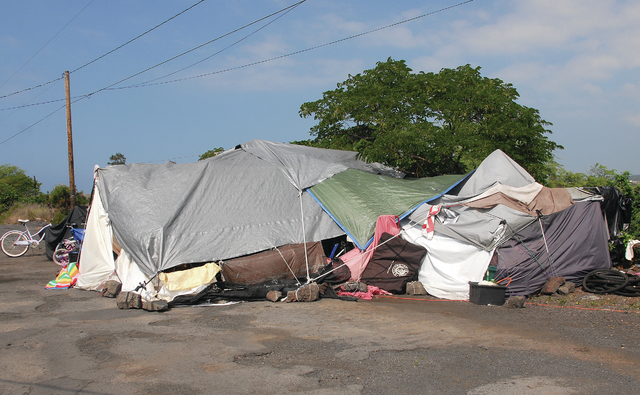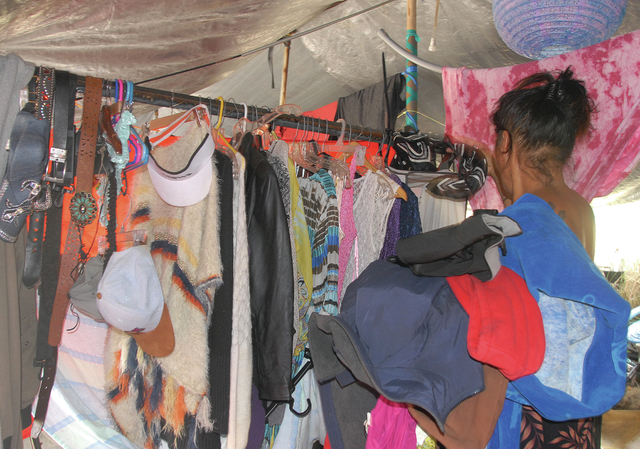Homeless at Old Kona Airport Park say they’ve been told to clear out; but ‘very few places to go’
KAILUA-KONA — Nellie has survived meagerly on the streets and beaches of Kona, making her home here and there for the better part of eight years.
ADVERTISING
Throughout her time as a homeless woman, Nellie has been ticketed and forced to vacate several homesteads — herded off sidewalks, pushed out of wooded areas and banned from setting up camp on shorelines. But for the past two months, she and her roommate have found more permanent refuge under a system of propped up tarps behind the Makaeo Events Pavilion on the mauka edge of Old Kona Airport Park.
A small community of homeless — roughly seven by Nellie’s count, although many more come and go as visitors — have built during the last few months a mini-tent city located out of the way of the park’s highly trafficked areas, including the athletic facilities, the beach and the Makaeo Walking Path.
The settlement area is cluttered with bikes and other scrap material, and a pile of refuse is heaped outside the gate blocking vehicle access from Kuakini Highway. The living spaces themselves, however, are not only organized, but equipped with furniture. Clothing is draped across clotheslines attached to fence poles and residents have coolers full of soft drinks.
The tents don’t just offer shelter. They offer a real sense of home, although they likely won’t for long.
Nellie said Hawaii County police notified her earlier this week she was violating park rules and gave her until the end of the month to pack her things and go. She says she has no problem with rules mandating she can’t live somewhere, but she takes exception to a system that doesn’t allow her to live anywhere.
“Where else can we go? That’s the big question. There’s very few places to go,” she said on Friday. “I try to abide by the rules. I try to keep my place clean. But dealing with the authorities and the laws, it’s not easy to figure out where to go next. They should just let us know where to go.”
Both Nellie and another resident of the Old Airport’s tent community, Michelle, claimed county officials they’d spoken to had ushered other homeless individuals to the small, out-of-the-way strip of land in an effort to move them off or out of the park’s high traffic areas. This, they said, was the catalyst for the homeless camp.
Whatever sparked the settlement, though, it is in violation of multiple county codes. Section 15-25 expressly prohibits residing in any county park unless a special permit or written agreement with the county is obtained. Camping of any sort in the Old Airport Park is also in violation of county code, said Department of Parks and Recreation Director Charmaine Kamaka.
The area of the park in which the camp is situated is technically state land, but an executive order issued in 2008 by then-Gov. Linda Lingle transferred the land to county management, rendering county code applicable to the goings on there.
Kamaka, who only recently reassumed control of the department as part of Mayor Harry Kim’s administration after serving in the same position under former Mayor Lorraine Inouye, said Kim called a meeting last week to begin gathering data about homeless populations in Hawaii Island parks.
“The mayor has a task force he’s put together, and he’s asked me to look at all of my parks to find out if, in fact, we do have a homeless population and provide that information to him so we can start doing enforcement,” Kamaka said. “We are strategizing a long-term plan to address it.”
State officials and members of law enforcement were present at the meeting, and Kamaka expects a follow-up to determine an enforcement strategy to be announced as soon as the data gathering process is complete. There is no timeline for enforcement as of yet, but she said she expects the process to move expeditiously.
Nellie and Michelle both said they understood the rules, but feel the concern about verbal or physical altercations between the public and their fellow homeless may be overblown.
“It’s after park hours and we’re not supposed to be down here, and (the police) rightfully are doing their job. But we don’t have anywhere to go,” said Michelle, who scavenges dumpsters for clothing that she then washes by hand and gives out to homeless who visit the settlement in seek of help.
“I’m sure sometimes it might be confusing for some people walking by because there are some homeless people who have mental illness problems. It might seem like (the homeless) are yelling at them, but they’re not. They’re yelling at the voices they hear or the spirits they see. A lot of them come here to talk to me because I listen to them.”
There have been some incidents with homeless camps at the park in general, however. Back in mid-July, a fire broke out at a homeless campsite at the northern edge of Old Kona Airport, which was extinguished without injuries. The blaze was the result of a campfire that apparently ignited a tent, fire officials said at the time.
Police could not be reached for comment about what they plan to do in the future or why they’ve yet to run off the homeless after months residing in the park, but all indications are the homeless camp won’t exist much longer.
Both Nellie and Michelle, who agreed to speak on record using only their first names, said they’d prefer to be elsewhere, to be indoors. Both applied for the micro-housing units recently constructed in the Kona Old Industrial Area and both were rejected.
They said they’d gladly frequent a shelter where they wouldn’t be hassled or ticketed for trespassing, but there’s far from enough space in existing facilities to go around. And both said when they’re eventually kicked out of their makeshift homes in the park, they won’t know where to turn.
“Getting tossed out will definitely make things more difficult, but it’s nothing we’ve never been through before,” Michelle said. “(But I wish) they’d let us be. We have to be somewhere.”




